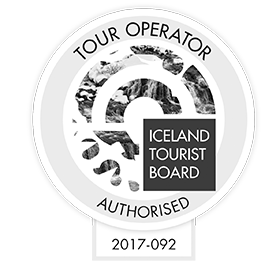- Vehicle Guide
- Driving in Iceland
- Our services
- Locations & Hours
- Travel Inspiration
- South Iceland: A complete guide
- Reynisfjara Beach in Iceland - Your Guide to a Safe Visit
- Best Times to Visit the Golden Circle in Iceland
- North Iceland: A Complete Guide for Drivers
- East Iceland A Complete Guide for Drivers
- West Iceland The Complete Driver’s Guide
- Your Ultimate Guide to Exploring Iceland’s Ring Road
- Driving the Diamond Circle in Iceland: Your Ultimate Guide
- Driving Iceland's Golden Circle: Your Ultimate Guide
- A 10-Day Itinerary in Iceland: Tips + Ideas
- The Perfect Itinerary for 7 Days in Iceland
- The Best Time to See the Northern Lights in Iceland with a Rental Car
- Renting a Camper in Iceland: The Complete Guide
- Getting to Iceland: A Comprehensive Guide on How to Reach the Land of Fire and Ice
- Nature Bath Locations in Iceland: A Complete Guide
- Iceland with Kids: A 5-Day Self-Drive Itinerary
- Winter Driving in Iceland: A Comprehensive Overview for Foreign Tourists
- The Total Solar Eclipse in Iceland – August 12, 2026
- Exploring Iceland's National Parks on a Self-Drive Adventure
- Exploring Iceland's Wonders: A Comprehensive Guide to Activities and Car Rentals
- Springtime in Iceland – Your Comprehensive Travel Guide
- Exploring Iceland's Most Popular Highland Routes
- The Pearls of Westfjords: The Ultimate Guide
- Exploring Iceland's Hidden Gems | Off-the-Beaten-Path Adventures
- Driving in Iceland in June: Tips for a Safe and Scenic Summer Road Trip
- Driving in Iceland in July: Tips, Routes & Rentals
- Driving in Iceland in August: Late-Summer Freedom on the Open Road
- Guide to Skaftafell Iceland Self-Drive A Journey Through Fire and Ice
- Eco-Friendly Road Trips in Iceland, Sustainable Travel Tips
- Photographer’s Paradise Top Scenic Drives in Iceland for Stunning Shots
- Iceland's Folklore and Legends A Road Trip Through Mythical Sites
- Iceland’s Midnight Sun and How to Make the Most of 24-Hour Daylight
- Exploring Iceland’s Viking Heritage: Top Historical Sites
- Chasing Waterfalls: A Road Trip to Iceland’s Most Spectacular Cascades
- Iceland's Volcanic Wonders: A Self-Drive Tour of Active and Dormant Volcanoes
- Tee Off in the Land of Fire and Ice: A Guide to Golfing in Iceland
- Birdwatching in Iceland: Puffins and Beyond
- Iceland’s Diverse Beaches: Beyond the Black Sands
- Icelandic Horses: The Unique Breed of the North
- Beyond the Ring Road: Iceland’s Hidden Scenic Drives
- Iceland’s Ice Caves: A Year-Round Adventure
- Wildlife Watching in Iceland: Where and When to Go
- Iceland’s Hidden Hot Springs: A Self-Drive Guide to Secret Soaks
- Navigating Iceland’s Weather: What to Expect Each Season
- Tröllaskagi Peninsula: Iceland’s Mountainous Marvel — A Scenic Road Trip with Höldur
- Mastering Iceland's Roundabouts: A Driver’s Guide
- Essential Tips for Renting a Car in Iceland
- Navigating Iceland’s One-Lane Bridges: Your Guide to Safe and Scenic Crossings
- Exploring Iceland’s Film Locations by Rental Car
- 5 Must-Visit Destinations Within Two Hours of Keflavík Airport
- Seasonal Car Rental Tips for Iceland’s Summer Festivals
- Understanding Iceland's F-Roads: How to Drive Safely Into the Highlands
- What Makes Iceland Unique: Top 15 Highlights for an Unforgettable Journey
- Driving and Hiking in Harmony: Explore Iceland's Natural Wonders with Höldur Car Rental
- Best Car to Rent in Iceland?
- Avoiding Common Car Rental Mistakes in Iceland
- Making Your Car Rental in Iceland Child-Friendly: Tips for Stress-Free Family Travel
- Exploring Akureyri, Iceland’s Northern Gem, with EasyJet and Europcar
- Renting a Manual or Automatic Car in Iceland
- Discover the Arctic Coast Way in Iceland with Höldur Car Rental
- How to Save on Fuel Costs During Your Iceland Road Trip
- Electric vs. 4x4 Rentals in Iceland: Which is Right for Your Trip?
- Top Scenic Detours Off Iceland's Ring Road
- Top Safety Tips for First-Time Drivers on Iceland’s Roads
- Cultural Pit Stops Along Iceland’s Ring Road
- Your Guide to Exploring Stuðlagil Canyon by Car: Iceland’s Basalt Beauty Awaits
- Day Trip Ideas From Reykjavik by Rental Car
- Visit Glymur Waterfall: The Ultimate Self-Drive Adventure from Reykjavík
- Discover the Volcanic Wonders of Lake Mývatn by Car
- Discovering the Magic of Snæfellsnes Peninsula by Car
- Your Self‑Drive Guide to Gullfoss Waterfall
- A Guide to Seljalandsfoss Waterfall in Iceland: Explore by Car
- Exploring Reykjanes Peninsula A Self Drive Guide
- Exploring Iceland Landmannalaugar by 4x4
- A Beginner's Guide to River Crossings in Iceland
- Best Car Rental Offers for Iceland’s Summer Adventures
- Your Self‑Drive Guide to Þingvellir National Park
- Your Ultimate Guide to Geysir, Iceland: All You Need to Know
- How to Pay for the Vaðlaheiðargöng Tunnel
- Your Guide to Visiting Jökulsárlón Glacier Lagoon
- The Diamond Beach in Iceland: A Sparkling Wonder Worth Visiting
- Parking fines in Iceland: how to pay and what to do if you receive one
- Where to find overnight parking in Reykjavík: a local’s guide for travellers
- How to park for free in Reykjavík: tips to save on your Iceland trip
- How to pay for parking in Reykjavík - A friendly guide for drivers in Iceland
- Game of Thrones Filming Locations in Iceland: A Self-Drive Guide
- How to Choose the Right Car Rental at Keflavík Airport
- Flying Within Iceland: Your Guide to Domestic Routes and Regional Airports
- Top 3 Must-See Attractions on Iceland's Golden Circle
- Hidden Gems Along the Golden Circle Route
- Your Essential Guide to Iceland: Currency, Culture, and Car Rental Tips
- How to Plan the Perfect Golden Circle Self-Drive Tour
- The Comprehensive Guide to Rental Car Sizes at Keflavik Airport
- Húsafell & Hallmundarhraun: Hidden Lava Field Adventures by Car
- Iceland Weather by Month: What to Expect and How to Drive Safely with Holdur Car Rental
- A Guide to Iceland’s Quirky Roadside Attractions
- Exploring Iceland’s Lava Tubes | Self-Drive Cave Adventures with Höldur Car Rental
- Coolcation in Iceland: Self-Drive Your Summer Escape to the North
- Driving Iceland’s Coastal Roads: A Guide to Lesser-Known Peninsulas
- Top Tips for Driving in Iceland Safely Year-Round
- The Best Rest Stops and Viewpoints Along Iceland's Ring Road
- Driving in Iceland in September: Embrace the Autumn Adventure
- Your Guide to Exploring Fjaðrárgljúfur – South Iceland’s Fairytale Canyon
- Explore Reykholt on a Self-Drive Tour in Iceland
- How to Choose the Right Insurance for Your Iceland Car Rental
- Hiking Múlagljúfur Canyon: Iceland’s Hidden Gem You Can’t Miss
- Understanding Iceland's Weather and How It Affects Driving Conditions
- Dyrhólaey: A Complete Self-Drive Guide to Iceland's Breathtaking South Coast
- Where to See Iceland’s Tectonic Plates Up Close
- Scenic Journey on Kjalvegur Road 35 Reykjavik to Akureyri
- Guide to Visiting Svartifoss with a Rental Car
- Kerið Crater Lake in Iceland: A Self-Drive Guide
- Your Complete Guide to Stokksnes, Iceland with a Rental Car
- Hengifoss Waterfall in Iceland: The Ultimate Self-Drive Guide
- Your Complete Guide to Visiting Skógafoss Waterfall with a Rental Car
- Into the Heart of Þórsmörk: Iceland’s Valley of Thunder
- Dynjandi Waterfall in Iceland: The Ultimate Self-Drive Guide
- Visiting Ásbyrgi Canyon in North Iceland by Car: A Complete Self-Drive Guide
- Driving in Iceland in October: Embrace the Autumn Transition
- Hraunfossar: Iceland’s Hidden Gem for Self-Drive Travellers
- Barnafoss Waterfall: Iceland’s Raging Cascade with a Legend
- Driving in Iceland in November: Your Complete Guide to a Spectacular Autumn Adventure
- Fishing in Iceland: All You Need to Know
- Öxarárfoss Waterfall in Iceland: A Self-Drive Guide with Höldur
- Life in Iceland: Essential Guide to Living in the Land of Fire and Ice
- People of Iceland - 12 Fun Facts About Icelanders
- Glaumbær Turf Houses: A Self-Drive Guide to Iceland’s Living History
- Húsavík: Whale Watching Capital of Iceland
- Svínafellsjökull Glacier: A Self-Drive Guide to Iceland’s Ice Giants
- Kirkjubæjarklaustur: A Historic South Coast Gem
- Vík í Mýrdal: South Iceland’s Coastal Treasure
- Namaskard: A Self-Drive Guide to Iceland’s Geothermal Wonderland
- Laufás Heritage Site: Where Iceland’s Past Lives On
- Navigating Iceland's Gravel Roads: Tips for a Safe and Smooth Drive
- Iceland's Best Stargazing Spots for Self-Drive Travellers
- Iceland's Best Picnic Spots: Scenic Stops for Self-Drive Adventures
- Top 5 Family-Friendly Hiking Trails Accessible by Rental Car
- 15 Tips for Travelling to Iceland
- How to Plan a Winter Photography Road Trip in Iceland
- Visiting Gljúfrabúi Waterfall — A Self-Drive Guide
- How to Spot Puffins in Iceland: A Self-Drive Adventure
- Your Essential Guide to Winter Tyres and Safe Driving in Iceland
- Iceland’s Most Active Volcanoes: A Self-Drive Guide
- Iceland’s Most Scenic Bridges and River Crossings: A Self-Drive Guide
- Iceland’s Most Instagrammable Spots for Self-Drive Travellers
- How Cold Is It in Iceland During Winter? A Self-Drive Guide
- Explore Dimmuborgir: A Self-Drive Guide to Iceland's Dark Castles
- The Ultimate Guide to Iceland’s Top 5 Waterfalls by Car
- Iceland’s Best Scenic Routes for Autumn Foliage: A Self-Drive Guide
- The Best Time to Visit Iceland for Self-Drive Travellers
- Self-Drive Adventures to Iceland’s Remote Lighthouses
- Selfoss Waterfall Self-Drive Guide: Explore Iceland Your Way
- All About the Icelandic Sheep
- Vestrahorn: A Self-Drive Guide to Iceland’s Stokksnes Peninsula
- Höfn, Iceland: The Lobster Town Self-Drive Guide
- Exploring Arnarstapi: A Self-Drive Guide
- A Guide to Iceland's Seasonal Foods for Your Road Trip
- Hverfjall Crater, Iceland: A Self-Drive Guide
- Self-Drive Guide to Visiting Askja
- A Self-Drive Guide to Visiting Kerlingarfjöll
- A Self-Drive Guide to Gunnuhver Geothermal Area
- Skriduklaustur, Iceland: A Self-Drive Guide to History & Culture
- Your Ultimate Guide to Visiting the Blue Lagoon in Iceland
- Borgarnes, Iceland: Top Things to Do & Self-Drive Guide
- A Guide to Glaciers in Iceland
- Car Rental Insurance in Iceland: What’s Usually Included, What’s Not & How to Choose
- Best Car Models for Iceland’s Terrain: Recommendations by Route
- Solo Traveller’s Guide to Self-Driving in Iceland
- Exploring Iceland’s Arctic Circle: What to See and Do
- How to Plan a Budget-Friendly Road Trip in Iceland
- The History of Iceland’s National Day: A Self-Drive Celebration
- Where to Spot Whales in Iceland: A Self-Drive Guide
- The Diamond Circle vs. The Golden Circle: Which Route is Right for You?
- Embracing a Greener Journey: Sustainability in Iceland
- Granni: A Self-Drive Guide to Iceland’s Neighboring Waterfall
- Háifoss: A Self-Drive Guide to Iceland’s Tallest Waterfall
- Iceland's Best Camping Spots for Road Trippers
- Gjáin: A Self-Drive Guide to Iceland’s Hidden Oasis
- Iceland's Hidden Waterfalls: Beyond the Tourist Trails
- Hjálparfoss: A Self-Drive Guide to Iceland’s Helping Falls
- Seasonal Self-Drive Itineraries in Iceland: What’s Open When?
- Kirkjufell: A Self-Drive Guide to Iceland’s Most Photographed Mountain
- Fjallabak Nature Reserve: A Self-Drive Guide to Iceland’s Rugged Highlands
- Hrafntinnusker: A Self-Drive and Hiking Guide to Iceland’s Obsidian Wilderness
- When to Visit Iceland: Northern Lights and Ice Caves vs. Hiking and Highland Adventures
- Visiting Laugarvatn Fontana Spa with a Rental Car: A Relaxing Icelandic Getaway
- Hvítserkur Rock: A Self-Drive Guide to Iceland’s Dragon of the North
- Skiing in Iceland: A Self-Drive Guide for Winter Adventurers
- Visiting the Mývatn Nature Baths by Car: A Self-Drive Guide
- Visiting Vök Baths in East Iceland: A Self-Drive Guide
- Visiting Skútustaðir Pseudo-Craters: A Self-Drive Guide
- Visiting Hljóðaklettar: A Self-Drive Guide on the Diamond Circle
- The Ultimate Guide to Exploring Reykjavik with a Rental Car
- Visiting Seljavallalaug: A Hidden Gem in South Iceland
- Guide to Sólheimajökull Glacier by Iceland Car Rental
- Eyjafjallajökull: Iceland’s Glacier Volcano
- Ísafjörður, Iceland: Your Ultimate Self-Drive Guide to the Westfjords
- What Continent is Iceland In? A Traveler's Guide
- Katla Volcano: A Guide to Iceland's Sleeping Giant
- The Magic of Icelandic Water: A Traveler's Guide
- A Guide to Exploring Akureyri by Rental Car
- A Self-Drive Guide to the Krafla Volcanic Region
- 12-Day Iceland Self-Drive: The Complete Itinerary
- Hekla Volcano: A Self-Drive Guide to Iceland's Gateway
- Visiting Deildartunguhver: A Self-Drive Guide to Europe’s Most Powerful Hot Spring
- Exploring Borgarfjörður: A Self-Drive Guide to West Iceland
- Exploring Stórurð: A Self-Drive and Hiking Guide to East Iceland
- Visiting the Forest Lagoon in North Iceland: A Self-Drive Guide
- Driving in Iceland in December: Embrace the Winter Wonderland
- Exploring Grábrók: A Self-Drive Guide to Iceland’s Volcanic Crater
- Exploring Látrabjarg: A Self-Drive Guide to Iceland’s Westernmost Point
- Iceland Car Hire Tips for UK Drivers: What You Need to Know
- 4-Day Iceland Winter Itinerary: The Best of the South
- Mount Mælifell: Iceland’s Emerald Volcano
- How Long to Drive Around Iceland? A Self-Drive Guide
- Driving in Iceland in January
- Exploring Djúpavík: A Self-Drive Guide to Iceland’s Remote Westfjords
- What to Wear in Iceland: Tips for Every Season
- Things to Do in Stykkishólmur: A Self-Drive Adventure Through Iceland’s Magical West
- The Secret Lagoon: Iceland’s Hidden Gem of Relaxation and Discovery
- The Silver Circle of Borgarfjörður: Your Ultimate Self-Drive Guide
- Snæfellsjökull: A Journey to Iceland’s Glacier of Legends
- Car Rental Iceland 4x4: Best 4WD Options for Your Trip
- What to See in Iceland: 20 Places You Don’t Want to Miss
- How to Prepare for an Iceland Road Trip
- Your Guide to Visiting Fagrifoss Waterfall by Car
- Exploring Stakkholtsgjá Canyon: A Self-Drive Adventure in Iceland
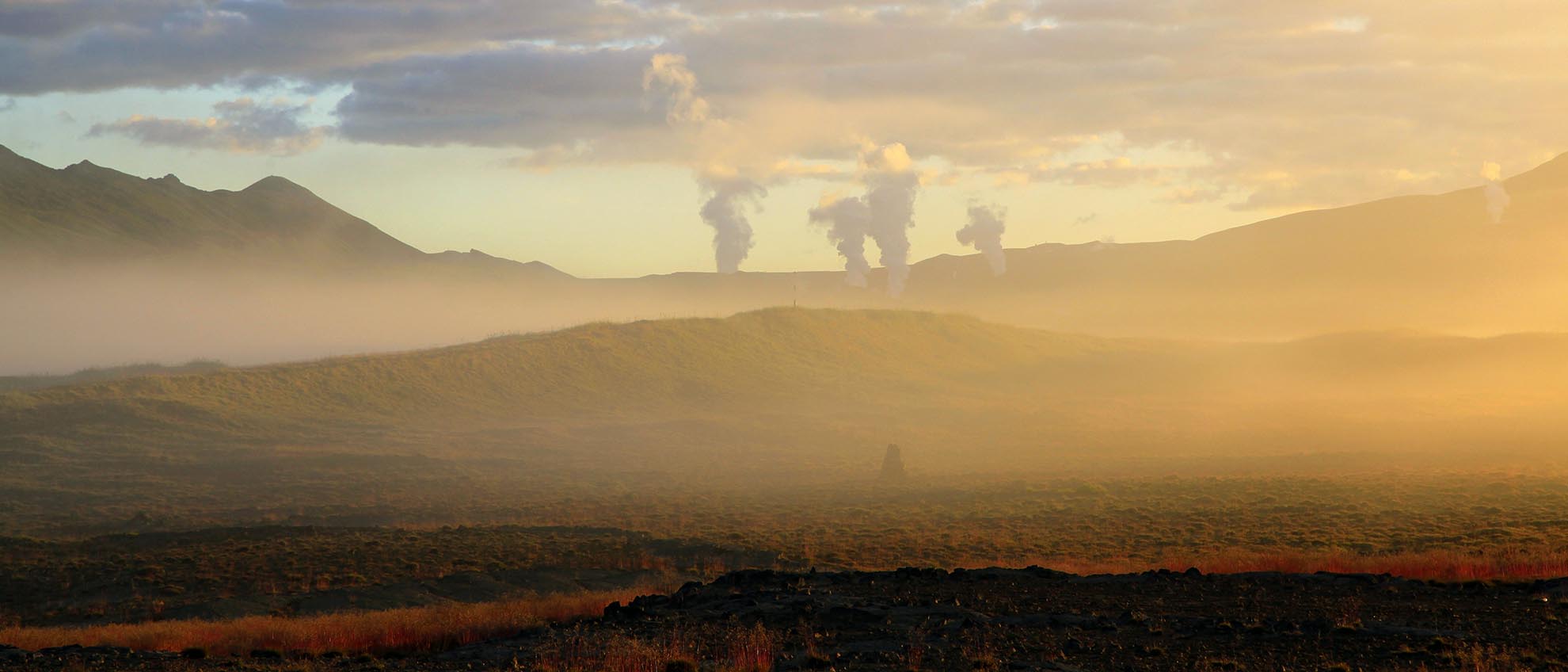
Iceland Attractions
A Self-Drive Guide to the Krafla Volcanic Region
25.09.2025
In North Iceland, the landscape speaks of immense power. The Krafla volcanic system, located near Lake Mývatn, is one of the country's most active and spectacular geothermal zones. A visit here is a journey into a world of steaming vents, vast lava fields, and vibrant crater lakes. For anyone exploring the Mývatn area by car, Krafla offers a raw and unforgettable look at the forces that shape our planet.
A self-drive tour provides the ideal way to discover the wonders of Krafla. The freedom to explore at your own pace allows you to fully appreciate the dramatic scenery and geological significance of this remarkable area. This guide contains everything you need to plan your trip, including details on Krafla's volcanic history, its key attractions, driving directions, and essential safety tips. With a reliable rental car, you can immerse yourself in one of Iceland's most dynamic landscapes.
The Volcanic Heart of Krafla
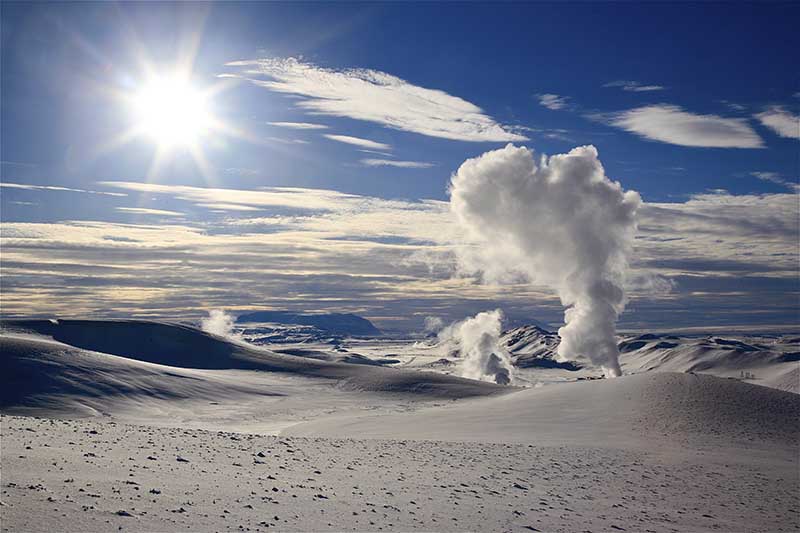
Krafla is not a single volcano but a massive caldera and fissure system that stretches for about 90 kilometers. It sits directly on the Mid-Atlantic Ridge, where the North American and Eurasian tectonic plates are pulling apart. This unique geological setting makes it one of the most volcanically active areas in Iceland.
The region's modern history is marked by the "Krafla Fires," a series of nine volcanic eruptions that occurred between 1975 and 1984. These events created the fresh, dark lava fields that you can still see today, some of which were still warm for years after the eruptions ceased. This history of recent activity makes Krafla a living laboratory for geologists and a fascinating destination for visitors.
Planning Your Self-Drive Trip to Krafla
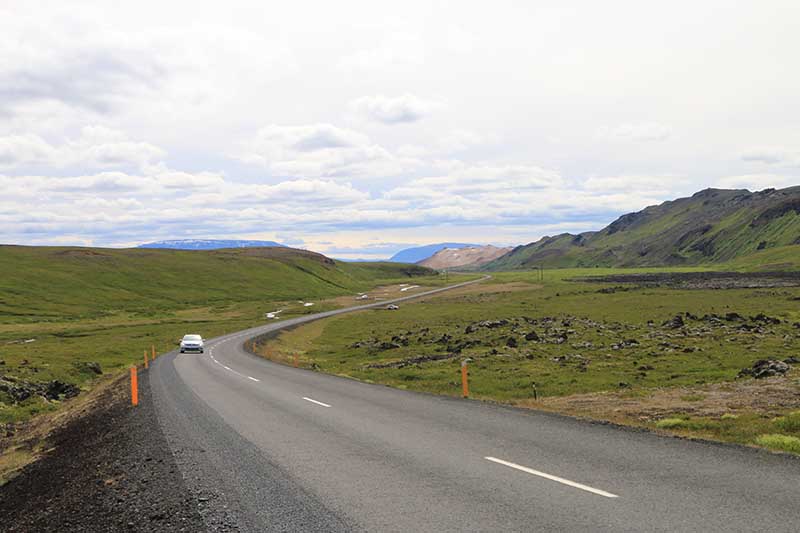
Renting a car is the most effective way to visit Krafla and the other geological marvels around Lake Mývatn. It gives you the flexibility to create a personalized itinerary and spend as much time as you need at each site.
Getting There
Krafla is situated just a short drive northeast of Lake Mývatn, making it an easy addition to any regional itinerary.
- From Lake Mývatn: From the Ring Road (Route 1) near Reykjahlíð, turn onto Route 863. This paved road leads you directly up into the Krafla area. The drive is approximately 10 kilometers (6 miles) and takes about 15 minutes.
- From Akureyri: The journey from Akureyri is about 100 kilometers (62 miles) and takes around 1 hour and 30 minutes. Follow the Ring Road eastward past Lake Mývatn until you see the turnoff for Route 863.
- From Egilsstaðir: If traveling from East Iceland, the drive is roughly 160 kilometers (100 miles) and takes just over 2 hours. Follow the Ring Road westward. The turnoff for Krafla will be on your right before you reach the main Lake Mývatn area.
Road Conditions and Vehicle Recommendations
The main road to Krafla (Route 863) is paved and generally well-maintained.
- Vehicle Choice (Summer): For travel between May and September, a 2WD vehicle is entirely sufficient for visiting Krafla and the other main attractions in the Mývatn region.
- Vehicle Choice (Winter): For any trip between October and April, a 4x4 vehicle equipped with studded winter tires is strongly recommended. North Iceland experiences significant snow and ice, and a 4x4 provides essential safety and traction, especially on the uphill drive to the Krafla area.
Höldur Car Rental offers a wide range of vehicles suitable for all seasons. With convenient pick-up locations at Keflavik Airport and in major towns like Akureyri, starting your adventure is simple and convenient.
Key Attractions in the Krafla Area
The Krafla region is home to several distinct and fascinating sites, all located within a few minutes' drive of each other.
Víti Crater
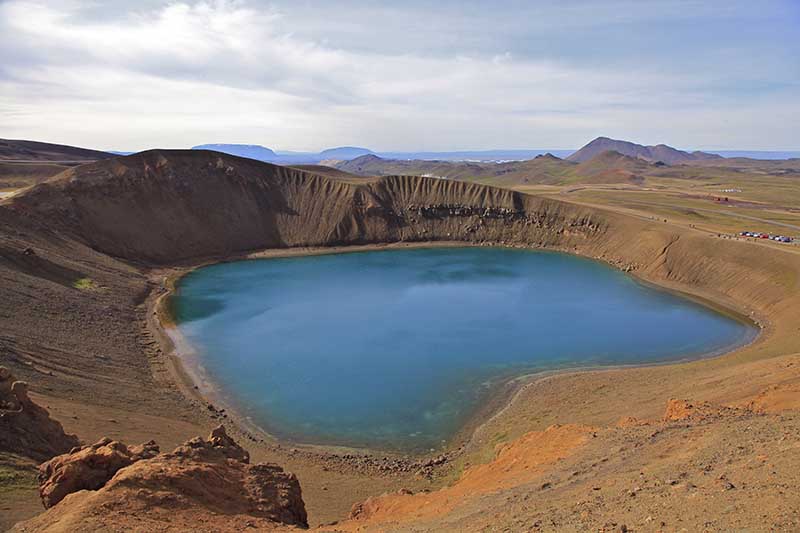
Often the main highlight for visitors, Víti crater (meaning "Hell" in Icelandic) is a stunning explosion crater formed during a massive eruption in 1724. It contains an opaque, turquoise-blue lake that creates a striking contrast with the surrounding dark, reddish-brown earth. A walking path circles the rim of the crater, offering spectacular views of the lake and the wider Krafla caldera. The walk is relatively easy and takes about 30-45 minutes to complete. From the rim, you can also see the Krafla Geothermal Power Station and the vast lava fields below.
Leirhnjúkur Lava Field
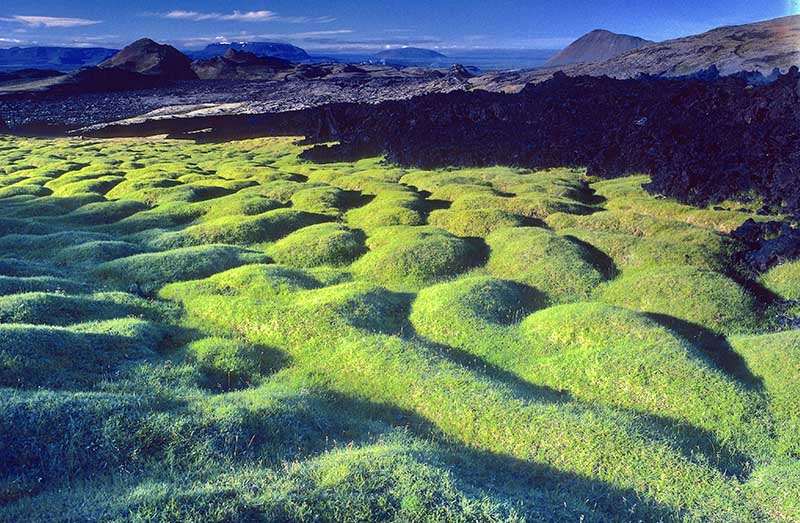
A short drive from Víti is the Leirhnjúkur parking area, the starting point for one of the most incredible hikes in Iceland. A network of boardwalks and trails leads you through an active geothermal area with bubbling mud pots and steaming fumaroles before opening into a vast, surreal lava field. This is the lava from the Krafla Fires of the 1970s and 80s. In some places, the rock is still warm to the touch, and steam rises from cracks in the ground. The trail takes you through jagged black lava formations, offering a visceral sense of the eruption's power. Plan for 1.5 to 2 hours for the main loop trail.
Krafla Geothermal Power Station
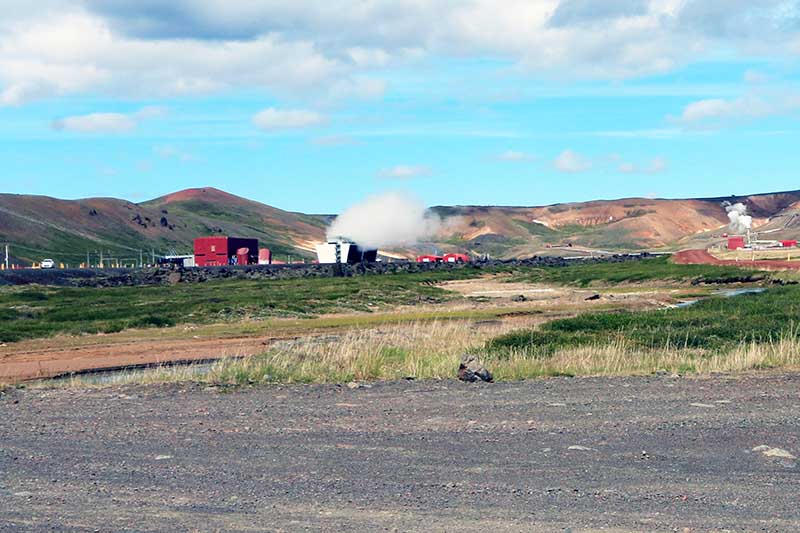
One of the first things you will notice as you drive up Route 863 is the Krafla Power Station. This facility, operated by Landsvirkjun, harnesses the immense geothermal energy of the region to generate electricity. Its network of pipes, turbines, and steam vents is an impressive sight and a powerful example of how Iceland utilizes its renewable resources. While public tours are not always available, the presence of the station itself adds to the unique, industrial-meets-nature atmosphere of the area. There is an information pavilion where you can often learn more about the plant's operations and the science of geothermal energy.
Best Time to Visit Krafla
Krafla can be visited year-round, but access and experience differ by season.
- Summer (June-August): This is the ideal time to visit. The roads are clear, all hiking trails are accessible, and the long daylight hours give you plenty of time for exploration. The vibrant blue of Víti crater is at its most striking under the summer sun.
- Winter (November-March): A winter visit offers a starkly beautiful, monochromatic landscape. The crater lake freezes over, and the lava fields are draped in snow, with steam rising dramatically into the cold air. However, hiking can be challenging due to snow and ice, and access to some trails may be restricted. Always check road conditions before you go, and be prepared for severe weather.
- Shoulder Seasons (April-May & September-October): These months offer a good compromise with fewer crowds. In autumn, the landscape takes on muted colors, while spring sees the snow melting to reveal the dark volcanic earth beneath. Be prepared for variable weather conditions.
Attractions Near Krafla
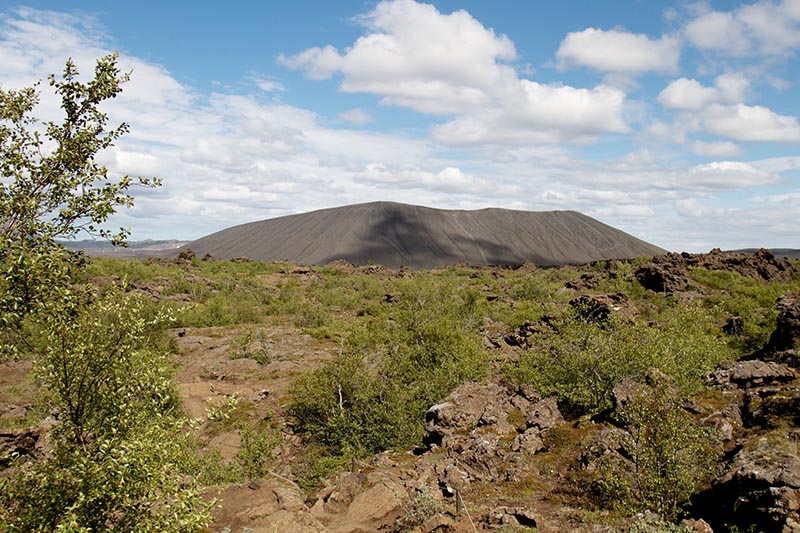
- Hverir Geothermal Area: En route to Krafla, you'll pass Námaskarð (Hverir), an extraordinary, Martian-like landscape alive with bubbling mud pots, hissing fumaroles, and pungent sulfurous steam.
- Dimmuborgir Lava Fields: Known as the "Dark Castles," Dimmuborgir is a labyrinth of towering, bizarrely shaped lava formations created by a massive eruption over 2,300 years ago. Well-marked walking trails allow you to explore this mythical landscape, which Icelandic folklore says is home to elves and trolls.
- Mývatn Nature Baths: The perfect place to relax after a day of sightseeing. Soak in the mineral-rich, milky-blue geothermal water of Mývatn Nature Baths while enjoying panoramic views of the area.
- Hverfjall Crater: Hike to the rim of this enormous tephra explosion crater of Hverfjall for a commanding 360-degree view of the entire Lake Mývatn basin.
- Skútustaðir Pseudo-Craters: These crater-like formations are not actually volcanic craters, but rather created by steam explosions when hot lava flowed over the wetlands. Take a stroll around this unique geological site and immerse yourself in its otherworldly atmosphere.
Safety and Practical Tips for Visitors
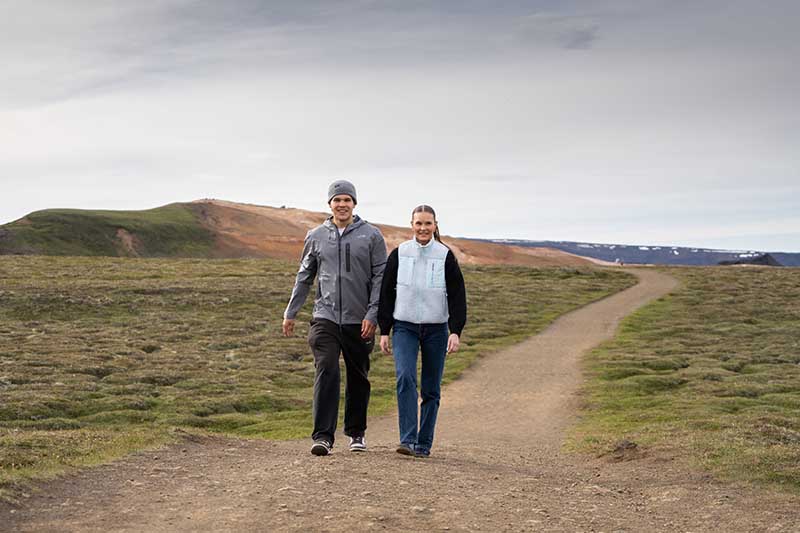
- Stay on Marked Paths: This is crucial, especially in the Leirhnjúkur area. The ground is extremely hot and unstable just off the trails. The crust can be thin, and stepping in the wrong place could result in severe burns.
- Wear Sturdy Footwear: The terrain, especially in the lava fields, is uneven and sharp. Good hiking boots are essential for both comfort and safety.
- Check the Weather: Conditions can change rapidly in North Iceland. Check the forecast on vedur.is before you set out and dress in warm, waterproof layers, even in summer.
- Facilities: There are limited facilities at Krafla. Public restrooms are available at the Leirhnjúkur parking area. For food and other services, you will need to return to the Reykjahlíð area by Lake Mývatn.
- Time Allocation: Plan to spend at least half a day (3-4 hours) to properly explore Víti crater and hike the Leirhnjúkur trail without rushing.
A self-drive tour to the Krafla volcanic system is an essential part of any Mývatn itinerary. It provides a powerful, up-close encounter with the geothermal forces that define Iceland. From the serene beauty of Víti crater to the raw, steaming landscapes of Leirhnjúkur, Krafla offers a profound connection to the living, breathing geology of our planet.




